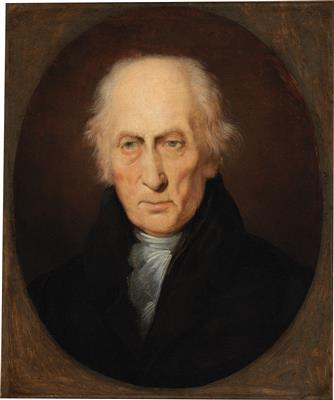Ferdinand Carl Christian Jagemann

(Weimar 1780–1820)
Portrait of Charles Joseph Prince de Ligne (Brussels 1735–1814 Vienna), signed, dated Jagemann 1813, oil on canvas, 59 x 48.5 cm, framed, (Rei)
Certificate by Dr. Renate Müller-Krumbach, Weimar December 2016, available.
Provenance:
German Private Collection.
Charles-Joseph, 7th prince of Ligne, was a famous Belgian personality of the 17th century. Born in the beautiful castle of Beloeil, he was heir to one of Belgium’s most important noble families. As his father, Claude Lamoral II (1685-1766), was a reputed field marshal of the Austrian Empire, it was only logical that he would follow in his father’s footsteps and start a military career himself.
In 1758, after he had proven himself in the Seven Years’ War – especially in the Battle of Kunersdorf – he was promoted to colonel at the early age of 23.
During the Brabant Revolution (1789-1790), which tried to overthrow the Habsburg rule, the Ligne family stayed loyal to the Austrian emperor. This decision resulted in their goods being seized by the French after they were forced into exile.
Although the family castle and their possessions were restituted to them, from 1794 onwards Charles chose to stay in Vienna.
There, he was mainly active as a writer and intellectual. In contact with Europe’s most brilliant minds, he exchanged letters and opinions with the empress Catherine the Great, whom he had met while working as a diplomat, but also the philosophers and writers Rousseau, Voltaire and Goethe.
Appreciated for his wit and charm – after all, he was a friend of Giacomo Casanova – he was a regular guest in Vienna’s salons. Charles is probably most famous for his comment, ‘Le congrès danse beaucoup, mais il ne marche pas’, which he made about the Congress of Vienna in 1814, the year he died.
The present painting was painted only a year before, in 1813. For this late portrait, de Ligne chose Ferdinand Jagemann, who had already painted him before. A life-size portrait of him sitting at his desk is mentioned in the Thieme-Becker (ill. 1, p. 633, no. 6), while an engraving by Karl August Schwerdtgeburth (1785-1878) of another bust portrait is preserved at the Austrian National Library.
Prince de Ligne and his wife Princess Franziska of Liechtenstein (1739-1821) are buried at the Kahlenberg Cemetery in Vienna.
Esperta: Mag. Dimitra Reimüller
 Mag. Dimitra Reimüller
Mag. Dimitra Reimüller
+43-1-515 60-355
19c.paintings@dorotheum.at
27.04.2017 - 18:00
- Prezzo realizzato: **
-
EUR 18.750,-
- Stima:
-
EUR 18.000,- a EUR 25.000,-
Ferdinand Carl Christian Jagemann
(Weimar 1780–1820)
Portrait of Charles Joseph Prince de Ligne (Brussels 1735–1814 Vienna), signed, dated Jagemann 1813, oil on canvas, 59 x 48.5 cm, framed, (Rei)
Certificate by Dr. Renate Müller-Krumbach, Weimar December 2016, available.
Provenance:
German Private Collection.
Charles-Joseph, 7th prince of Ligne, was a famous Belgian personality of the 17th century. Born in the beautiful castle of Beloeil, he was heir to one of Belgium’s most important noble families. As his father, Claude Lamoral II (1685-1766), was a reputed field marshal of the Austrian Empire, it was only logical that he would follow in his father’s footsteps and start a military career himself.
In 1758, after he had proven himself in the Seven Years’ War – especially in the Battle of Kunersdorf – he was promoted to colonel at the early age of 23.
During the Brabant Revolution (1789-1790), which tried to overthrow the Habsburg rule, the Ligne family stayed loyal to the Austrian emperor. This decision resulted in their goods being seized by the French after they were forced into exile.
Although the family castle and their possessions were restituted to them, from 1794 onwards Charles chose to stay in Vienna.
There, he was mainly active as a writer and intellectual. In contact with Europe’s most brilliant minds, he exchanged letters and opinions with the empress Catherine the Great, whom he had met while working as a diplomat, but also the philosophers and writers Rousseau, Voltaire and Goethe.
Appreciated for his wit and charm – after all, he was a friend of Giacomo Casanova – he was a regular guest in Vienna’s salons. Charles is probably most famous for his comment, ‘Le congrès danse beaucoup, mais il ne marche pas’, which he made about the Congress of Vienna in 1814, the year he died.
The present painting was painted only a year before, in 1813. For this late portrait, de Ligne chose Ferdinand Jagemann, who had already painted him before. A life-size portrait of him sitting at his desk is mentioned in the Thieme-Becker (ill. 1, p. 633, no. 6), while an engraving by Karl August Schwerdtgeburth (1785-1878) of another bust portrait is preserved at the Austrian National Library.
Prince de Ligne and his wife Princess Franziska of Liechtenstein (1739-1821) are buried at the Kahlenberg Cemetery in Vienna.
Esperta: Mag. Dimitra Reimüller
 Mag. Dimitra Reimüller
Mag. Dimitra Reimüller
+43-1-515 60-355
19c.paintings@dorotheum.at
|
Hotline dell'acquirente
lun-ven: 10.00 - 17.00
kundendienst@dorotheum.at +43 1 515 60 200 |
| Asta: | Dipinti dell’Ottocento |
| Tipo d'asta: | Asta in sala |
| Data: | 27.04.2017 - 18:00 |
| Luogo dell'asta: | Wien | Palais Dorotheum |
| Esposizione: | 15.04. - 27.04.2017 |
** Prezzo d’acquisto comprensivo dei diritti d’asta acquirente e IVA
Non è più possibile effettuare un ordine di acquisto su Internet. L'asta è in preparazione o è già stata eseguita.
